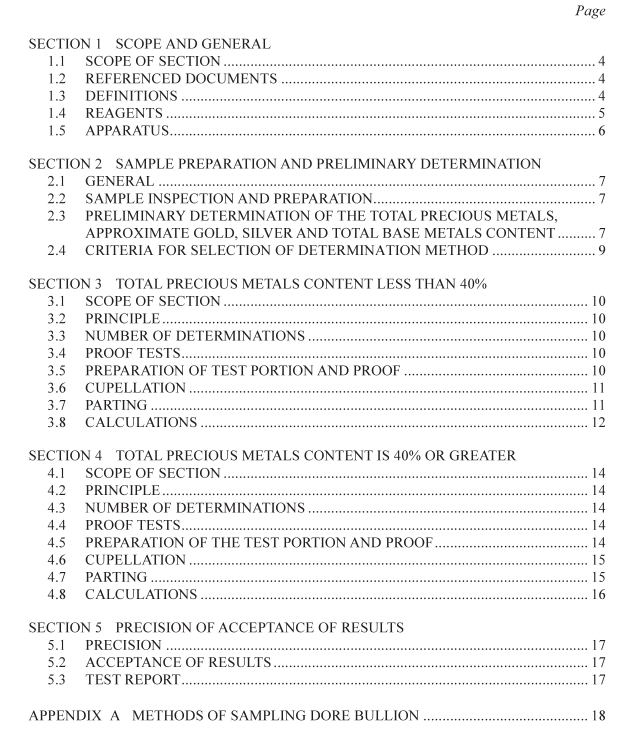AS 3515.1 pdf download – Gold and gold bearing alloys Part 1: Determination of gold content (less than 30%)—Gravimetric (fire assay) method

AS 3515.1 pdf download – Gold and gold bearing alloys Part 1: Determination of gold content (less than 30%)—Gravimetric (fire assay) method
This Section specifies the preliminary determination undertaken to determine the totalprecious metal content in order to choose which of the two procedures set out in Sections 3and 4 is applicable, see Clause 2.4.
2.2SAMPLE INSPECTION AND PREPARATION
The sample shall be taken and inspected for the presence of discernible inhomogeneities,contaminants and,in the case of a sample prepared by the vacuum tube method, piping(hollow centre). If any of these defects are present,the sample shall be rejected. If notsupplied in a form suitable for assay, the sample shall be flattened to render it suitable forcutting.
NOTE: The sample should be taken using one of the options listed in Appendix A.
2.3 PRELIMINARY DETERMINATION OF THE TOTAL PRECIOUS METALS,APPROXIMATE GOLD, SILVER AND TOTAL BASE METALS CONTENT
2.3.1 Test portion preparation
lf the total precious metals content, approximate gold content or total base metals content isunknown, a preliminary assay shall be carried out as follows:
(a)Fold one sheet of approximately 7 g of lead foil (1.4.8) into a cone.
(b)weigh a test portion of approximately 500 mg and record the mass (m ) to 0.1 mg.(c)Fold the lead cone tightly around the contents and carefully squeeze it into a compact
form.
2.3.2 Cupellation
The cupellation procedure shall be as follows:
(a) Preheat the cupellation furnace (1.5.4) to 1100C±50°C. If nickel is present,the
cupellation temperature should be at least 1100°c.
(b)
Place cupels (1.5.1) into the preheated cupellation furnace using one cupel for eachtest portion and allow the cupels to attain the furnace temperature.
NOTE: Cupels should be arranged so that test portions are evenly distributed from left toright and from the back to the front of the furnace.
(c)To minimize the temperature loss in the cupellation furnace, quickly place the folded
cones onto preheated cupels in order from left to right and from the back to the front.(d)Maintain the samples at the appropriate temperature until cupellation is complete,
(25 min to 30 min), ensuring that adequate airflow is maintained through the furnaceto promote oxidation.
(e)
Remove the cupels from the furnace,maintaining them in the original spatial order,and allow them to cool in a well ventilated area.
(f)
As soon as the material has solidified, loosen each prill from its cupel.Check that theprills are smooth,hard and shiny. If any prills are dull, flat or fragmented (this beingdue to a high base-metal content), the determination shall be repeated with additionallead.
(g)Place each cooled prill on its side on the anvil (1.5.2) and hammer it once firmly to
dislodge adhering cupel material.Carefully brush off excess magnesite with the prillcleaning brush (1.5.8).
(h) Weigh the prill and record the mass to 0.1 mg (mz).2.3.3 Re-inquarting
The procedure shall be as follows:
(a)To a folded 4 g lead cone,add the sample prill (2.3.2),400 mg of silver and
approximately 40 mg of copper.
(b)Fold the lead cones tightly around the contents and carefully squeeze to a compact
form.
(c)Cupel again in accordance with Clause 2.3.2 (a) to (g).2.3.4 Parting
The procedure for parting shall be as follows:
(a)Hammer each flattened prill into an oval sheet,ensuring that a thin edge is produced
to facilitate rolling. Anneal each sheet briefly at 800°C 50°C in a furnace (1.5.5).
(b)
Pass each sheet through rollers (1.5.6) reducing the roller clearance with each passuntil the resultant sheets are between 0.2 mm and 0.3 mm in thickness.
(c)Anneal each strip as in Step (a).
(d)Crimp over the end and carefully roll each strip into a compact cornet. Sufficient
clearance should be allowed between each fold to allow acid penetration of thecornet.
(e) Place the cornet into a 150 mL beaker and add 50 mL nitric acid 1:2 (1.4.3) to
complete the parting.
(f)Gently boil until the fumes oxides of nitrogen cease to evolve then decant the acid
waste.
(g)
Wash until acid-free and transfer the residue to a ceramic crucible with water.(h) Decant the water and dry the residue on a hotplate.
(i)Anneal the gold residue at a temperature of 800°C 土50°C in a furnace ( 1.5.5).j)Allow the gold residue to cool to room temperature.
(k)Weigh the gold (ms), and record the mass to 0.1 mg.









